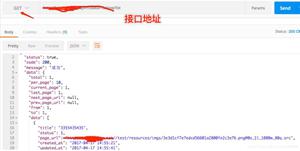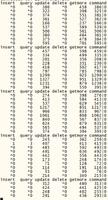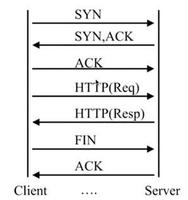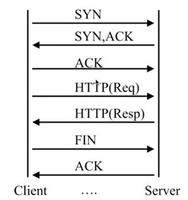java发送http的get、post请求

Http请求类
1 package wzh.Http;2
3 import java.io.BufferedReader;
4 import java.io.IOException;
5 import java.io.InputStreamReader;
6 import java.io.PrintWriter;
7 import java.net.URL;
8 import java.net.URLConnection;
9 import java.util.List;
10 import java.util.Map;
11
12 public class HttpRequest {
13 /**
14 * 向指定URL发送GET方法的请求
15 *
16 * @param url
17 * 发送请求的URL
18 * @param param
19 * 请求参数,请求参数应该是 name1=value1&name2=value2 的形式。
20 * @return URL 所代表远程资源的响应结果
21 */
22 public static String sendGet(String url, String param) {
23 String result = "";
24 BufferedReader in = null;
25 try {
26 String urlNameString = url + "?" + param;
27 URL realUrl = new URL(urlNameString);
28 // 打开和URL之间的连接
29 URLConnection connection = realUrl.openConnection();
30 // 设置通用的请求属性
31 connection.setRequestProperty("accept", "*/*");
32 connection.setRequestProperty("connection", "Keep-Alive");
33 connection.setRequestProperty("user-agent",
34 "Mozilla/4.0 (compatible; MSIE 6.0; Windows NT 5.1;SV1)");
35 // 建立实际的连接
36 connection.connect();
37 // 获取所有响应头字段
38 Map<String, List<String>> map = connection.getHeaderFields();
39 // 遍历所有的响应头字段
40 for (String key : map.keySet()) {
41 System.out.println(key + "--->" + map.get(key));
42 }
43 // 定义 BufferedReader输入流来读取URL的响应
44 in = new BufferedReader(new InputStreamReader(
45 connection.getInputStream()));
46 String line;
47 while ((line = in.readLine()) != null) {
48 result += line;
49 }
50 } catch (Exception e) {
51 System.out.println("发送GET请求出现异常!" + e);
52 e.printStackTrace();
53 }
54 // 使用finally块来关闭输入流
55 finally {
56 try {
57 if (in != null) {
58 in.close();
59 }
60 } catch (Exception e2) {
61 e2.printStackTrace();
62 }
63 }
64 return result;
65 }
66
67 /**
68 * 向指定 URL 发送POST方法的请求
69 *
70 * @param url
71 * 发送请求的 URL
72 * @param param
73 * 请求参数,请求参数应该是 name1=value1&name2=value2 的形式。
74 * @return 所代表远程资源的响应结果
75 */
76 public static String sendPost(String url, String param) {
77 PrintWriter out = null;
78 BufferedReader in = null;
79 String result = "";
80 try {
81 URL realUrl = new URL(url);
82 // 打开和URL之间的连接
83 URLConnection conn = realUrl.openConnection();
84 // 设置通用的请求属性
85 conn.setRequestProperty("accept", "*/*");
86 conn.setRequestProperty("connection", "Keep-Alive");
87 conn.setRequestProperty("user-agent",
88 "Mozilla/4.0 (compatible; MSIE 6.0; Windows NT 5.1;SV1)");
89 // 发送POST请求必须设置如下两行
90 conn.setDoOutput(true);
91 conn.setDoInput(true);
92 // 获取URLConnection对象对应的输出流
93 out = new PrintWriter(conn.getOutputStream());
94 // 发送请求参数
95 out.print(param);
96 // flush输出流的缓冲
97 out.flush();
98 // 定义BufferedReader输入流来读取URL的响应
99 in = new BufferedReader(
100 new InputStreamReader(conn.getInputStream()));
101 String line;
102 while ((line = in.readLine()) != null) {
103 result += line;
104 }
105 } catch (Exception e) {
106 System.out.println("发送 POST 请求出现异常!"+e);
107 e.printStackTrace();
108 }
109 //使用finally块来关闭输出流、输入流
110 finally{
111 try{
112 if(out!=null){
113 out.close();
114 }
115 if(in!=null){
116 in.close();
117 }
118 }
119 catch(IOException ex){
120 ex.printStackTrace();
121 }
122 }
123 return result;
124 }
125 }
调用方法:
1 public static void main(String[] args) {2 //发送 GET 请求
3 String s=HttpRequest.sendGet("http://localhost:6144/Home/RequestString", "key=123&v=456");
4 System.out.println(s);
5
6 //发送 POST 请求
7 String sr=HttpRequest.sendPost("http://localhost:6144/Home/RequestPostString", "key=123&v=456");
8 System.out.println(sr);
9 }
原文:java发送http的get、post请求 - 上校 - 博客园 http://www.cnblogs.com/zhuawang/archive/2012/12/08/2809380.html
Http请求类
1 package wzh.Http;2
3 import java.io.BufferedReader;
4 import java.io.IOException;
5 import java.io.InputStreamReader;
6 import java.io.PrintWriter;
7 import java.net.URL;
8 import java.net.URLConnection;
9 import java.util.List;
10 import java.util.Map;
11
12 public class HttpRequest {
13 /**
14 * 向指定URL发送GET方法的请求
15 *
16 * @param url
17 * 发送请求的URL
18 * @param param
19 * 请求参数,请求参数应该是 name1=value1&name2=value2 的形式。
20 * @return URL 所代表远程资源的响应结果
21 */
22 public static String sendGet(String url, String param) {
23 String result = "";
24 BufferedReader in = null;
25 try {
26 String urlNameString = url + "?" + param;
27 URL realUrl = new URL(urlNameString);
28 // 打开和URL之间的连接
29 URLConnection connection = realUrl.openConnection();
30 // 设置通用的请求属性
31 connection.setRequestProperty("accept", "*/*");
32 connection.setRequestProperty("connection", "Keep-Alive");
33 connection.setRequestProperty("user-agent",
34 "Mozilla/4.0 (compatible; MSIE 6.0; Windows NT 5.1;SV1)");
35 // 建立实际的连接
36 connection.connect();
37 // 获取所有响应头字段
38 Map<String, List<String>> map = connection.getHeaderFields();
39 // 遍历所有的响应头字段
40 for (String key : map.keySet()) {
41 System.out.println(key + "--->" + map.get(key));
42 }
43 // 定义 BufferedReader输入流来读取URL的响应
44 in = new BufferedReader(new InputStreamReader(
45 connection.getInputStream()));
46 String line;
47 while ((line = in.readLine()) != null) {
48 result += line;
49 }
50 } catch (Exception e) {
51 System.out.println("发送GET请求出现异常!" + e);
52 e.printStackTrace();
53 }
54 // 使用finally块来关闭输入流
55 finally {
56 try {
57 if (in != null) {
58 in.close();
59 }
60 } catch (Exception e2) {
61 e2.printStackTrace();
62 }
63 }
64 return result;
65 }
66
67 /**
68 * 向指定 URL 发送POST方法的请求
69 *
70 * @param url
71 * 发送请求的 URL
72 * @param param
73 * 请求参数,请求参数应该是 name1=value1&name2=value2 的形式。
74 * @return 所代表远程资源的响应结果
75 */
76 public static String sendPost(String url, String param) {
77 PrintWriter out = null;
78 BufferedReader in = null;
79 String result = "";
80 try {
81 URL realUrl = new URL(url);
82 // 打开和URL之间的连接
83 URLConnection conn = realUrl.openConnection();
84 // 设置通用的请求属性
85 conn.setRequestProperty("accept", "*/*");
86 conn.setRequestProperty("connection", "Keep-Alive");
87 conn.setRequestProperty("user-agent",
88 "Mozilla/4.0 (compatible; MSIE 6.0; Windows NT 5.1;SV1)");
89 // 发送POST请求必须设置如下两行
90 conn.setDoOutput(true);
91 conn.setDoInput(true);
92 // 获取URLConnection对象对应的输出流
93 out = new PrintWriter(conn.getOutputStream());
94 // 发送请求参数
95 out.print(param);
96 // flush输出流的缓冲
97 out.flush();
98 // 定义BufferedReader输入流来读取URL的响应
99 in = new BufferedReader(
100 new InputStreamReader(conn.getInputStream()));
101 String line;
102 while ((line = in.readLine()) != null) {
103 result += line;
104 }
105 } catch (Exception e) {
106 System.out.println("发送 POST 请求出现异常!"+e);
107 e.printStackTrace();
108 }
109 //使用finally块来关闭输出流、输入流
110 finally{
111 try{
112 if(out!=null){
113 out.close();
114 }
115 if(in!=null){
116 in.close();
117 }
118 }
119 catch(IOException ex){
120 ex.printStackTrace();
121 }
122 }
123 return result;
124 }
125 }
调用方法:
1 public static void main(String[] args) {2 //发送 GET 请求
3 String s=HttpRequest.sendGet("http://localhost:6144/Home/RequestString", "key=123&v=456");
4 System.out.println(s);
5
6 //发送 POST 请求
7 String sr=HttpRequest.sendPost("http://localhost:6144/Home/RequestPostString", "key=123&v=456");
8 System.out.println(sr);
9 }
原文:java发送http的get、post请求 - 上校 - 博客园 http://www.cnblogs.com/zhuawang/archive/2012/12/08/2809380.html
以上是 java发送http的get、post请求 的全部内容, 来源链接: utcz.com/z/392392.html









